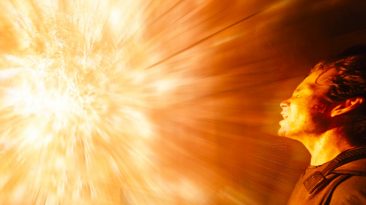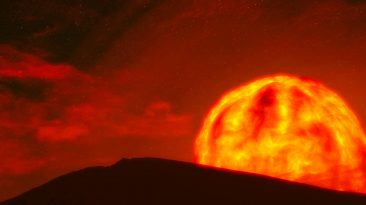Imagine you had to experience an apocalypse every day. Volcanic eruptions, tsunamis, asteroid showers. Every day would be a struggle for survival. That’s because Earth is now a moon of Jupiter. Why are we being hit with so many asteroids? Could we survive in underground bunkers? And how much damage would Jupiter’s gravity cause?
Now that we’ve joined Jupiter’s 79 other moons, let’s scope out our new neighborhood. Jupiter is the largest planet in our Solar System. It’s so big that it could hold over 1,300 Earths inside it. For perspective, think of Earth as a grape. Compared to us, Jupiter would be the size of a basketball.
It would be a heck of a view, though. Jupiter would take up an enormous chunk of the sky. Once you’re done star-gazing, you’d notice how cold it’s gotten. That’s because Jupiter is 778 million km (484 million mi) away from the Sun. The nice, warm Sun. That means 25 times less luminosity and 25 times less heat than we have now. And that’s only a small taste of what’s changed.
One year on Earth is one month on Jupiter since it takes Jupiter 12 years to go around the Sun. If we were to compare Earth to Jupiter’s closest moon, Io, your days would be about 40 hours long. The good news is, it’ll give you lots of time to prepare. Look alive, you’ve got some work to do.
If you want to survive out here, you’d need to go underground. You and humanity would set up shop in subterranean bunkers. Now, don’t be expecting a five-star bed and breakfast, alright? You’ll be surrounded by thick, tightly sealed concrete walls so no gas, water or radiation can get through.
And before you get nice and settled, you’ll need to ensure your bunker has a reliable power source, sound air filtration system, and ample food and water supply. If you really feel like a hermit, you could convince your vault survival crew to build hydroponic farms.
These farms use nutrient-rich water and artificial light to grow plants instead of the usual soil and sunlight combo. And speaking of sunlight, you’re going to miss it. A lot. Because you’re now living underground, you’d be lacking in the vitamin D department. A workaround may be introducing some fish into your survival diet.
Using aquaponics, fish and plants can be farmed together, even indoors. Eating fish will provide you with that sweet, essential vitamin D your body is craving. I know it sounds like a lot of work, but trust me, it’s worth it. You wouldn’t want to live on the surface. That’s because, topside, there’s a daily apocalypse.
The gravitational pull from Jupiter’s other nearby moons, not to mention the planet itself, would generate extreme tidal forces. The whole world would be falling apart, literally. Monday, you’d have to deal with an earthquake. Tuesday, it’s volcanic eruptions. Wednesdays, you’ve got tsunamis. And by the weekend, you’ve got the worst of all. Asteroid impacts.
Every month, Jupiter is hit by anywhere from 12 to 60 comets or asteroids. The good news is Jupiter will take the lion’s share of the bombardment. The bad news is the ones that hit us could still do some serious damage. Jupiter’s gravitational pull makes asteroids move faster.
It’s basically an asteroid with a nitrous speed boost, reaching a collision speed of about 216,000 km/h (134,000 mph). And that’s just the minimum! If Earth became one of Jupiter’s moons, we’d be directly in the line of fire. One such event occurred in 1994 when the Shoemaker-Levy 9 comet collided with Jupiter.
If we took the hit instead of Jupiter, the 2 km (1.2 mi) comet would strike us like a shotgun blast. Seriously, because of Jupiter’s gravity, the comet would break up into 20 pieces. The collisions from these fragments would be like getting hit by 300 million atomic bombs. Plumes of debris would shoot as high as 3,000 km (1,900 mi). And that’s not all.
These hits would cause our atmosphere to reach scorching temperatures of around 40,000 °C (71,000 °F). Do you know why they called it the Shoemaker? Because it just kicked our planet’s ass. But let’s say Jupiter took one for the team, and the asteroids missed us. You’re not out of the woods yet.
As you peeked your head out of the bunker to look at the surface, you’d realize your Geiger counter is going crazy. The weather today? Highly irradiated. If you lingered too long and got hit with 200 rads, you’d experience radiation sickness. You could look forward to vomiting, fatigue and diarrhea, but still, you’d survive.
Once you go past 200 rads, however, things would go from bad to worse. And for the record, rad is radiation absorbed dose. It puts a number on how much energy your body absorbed from radiation. And even as little as two rads can cause chromosomal damage. Except Jupiter’s magnetic field is 10 times stronger than Earth’s, meaning that it emits a million times more radiation.
At 400 rads, you’d really start to hurt. Your chances of dying would reach 50%, and you could feel your intestines and marrow falling apart. At 600 rads, you’d be dead. You may want to get back inside the bunker. But before you do, take in that view one last time. You’d be able to see some of Jupiter’s other moons, like Callisto, Ganymede and Io.
If you looked closely enough, you could even witness Io’s volcanoes erupting. Even cooler, the aurora would be a full-time light show thanks to Jupiter’s radiation. Beautiful, isn’t it? Alright, pack it up. Back in the bunker. I don’t feel so good. If Earth orbited Jupiter, it’s safe to say things would be less than ideal. But what if we turned the tables, and Jupiter’s 80 moons came to us? Would it be a paradise? Or a cosmic disaster?



























